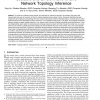1798 search results - page 169 / 360 » A Tree for All Seasons |
BMCBI
2007
13 years 9 months ago
2007
Background: In general, the construction of trees is based on sequence alignments. This procedure, however, leads to loss of informationwhen parts of sequence alignments (for inst...
BMCBI
2008
13 years 9 months ago
2008
Background: Phylogenies, i.e., the evolutionary histories of groups of taxa, play a major role in representing the interrelationships among biological entities. Many software tool...
BMCBI
2006
13 years 9 months ago
2006
Background: The neighbor-joining method by Saitou and Nei is a widely used method for constructing phylogenetic trees. The formulation of the method gives rise to a canonical (n3)...
BMCBI
2006
13 years 9 months ago
2006
Background: Phylogenetic methods which do not rely on multiple sequence alignments are important tools in inferring trees directly from completely sequenced genomes. Here, we exte...
TPDS
2008
13 years 9 months ago
2008
To construct an efficient overlay network, the information of underlay is important. We consider using end-to-end measurement tools such as traceroute to infer the underlay topolog...




